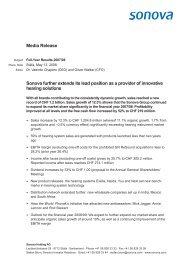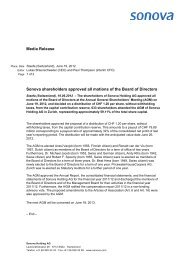ANNUAL REPORT 2008/09 - Sonova
ANNUAL REPORT 2008/09 - Sonova
ANNUAL REPORT 2008/09 - Sonova
You also want an ePaper? Increase the reach of your titles
YUMPU automatically turns print PDFs into web optimized ePapers that Google loves.
3.1 Principles of consolidation<br />
Investments in subsidiaries<br />
Investments in subsidiaries are fully consolidated.<br />
These are entities over which <strong>Sonova</strong> Holding AG<br />
directly or indirectly exercises control. Control is the<br />
power to govern the fi nancial and operating poli -<br />
cies of an entity so as to obtain benefi ts from its ac -<br />
tivities. Control is presumed to exist when the<br />
parent owns, directly or indirectly through subsidiaries,<br />
more than half of the voting power of an entity<br />
unless, in exceptional circumstances, it can be clear -<br />
ly demonstrated that such ownership does not constitute<br />
control. For the consolidated entities, 100%<br />
of assets, liabilities, income and expenses are included.<br />
The interests of minority shareholders in equity<br />
and net income or loss are shown separately<br />
in the balance sheet and income statement. Changes<br />
in minority interests are accounted for using the<br />
“modifi ed parent company model”, with any excess<br />
of purchase consideration over the carrying values<br />
of the attributable net assets acquired being<br />
recorded as goodwill.<br />
Group Companies acquired during the year are<br />
included in the consolidation from the date on which<br />
control over the company is transferred to the<br />
Group, and are excluded from the consolidation as<br />
of the date the Group ceases to have control over<br />
the company. Intercompany balances and transactions<br />
(incl. unrealized profi t on intercompany in -<br />
ventories) are eliminated in full.<br />
Investments in associates<br />
Investments in associates are accounted for<br />
using the equity method of accounting. These are<br />
entities in which <strong>Sonova</strong> has signifi cant infl uence<br />
and which are neither subsidiaries nor joint<br />
ventures of <strong>Sonova</strong>. Signifi cant infl uence is the<br />
power to par ticipate in the fi nancial and operating<br />
policy decisions of the acquired company but is<br />
not control or joint control over those policies (usu-<br />
66 CONSOLIDATED FINANCIAL STATEMENTS<br />
ally 20 – 50% of voting rights). Under the equity<br />
method, the investment in an associate is initially<br />
recognized at cost (including goodwill on acquisition)<br />
and the carrying amount is increased or decreased<br />
to recognize <strong>Sonova</strong>’s share of profi t or<br />
loss of the acquired company after the acquisition<br />
date. In order to apply the equity method the most<br />
recent available fi nancial statements of an associate<br />
are used, however due to practicability reasons<br />
the reporting dates might vary up to three months<br />
from the Group’s reporting date. The net assets<br />
and results from associates are adjusted, if necessary,<br />
to comply with the Group’s accounting policies.<br />
The Group’s share of equity in associated companies,<br />
consolidated using the equity method, is<br />
shown in the balance sheet as “Investments in<br />
associates/joint ventures,” and its share of the re -<br />
sults of operations for the year is shown in the<br />
income statement as “Share of gain/(loss) in asso -<br />
ciates/joint ventures”.<br />
Associates acquired during the year are accounted<br />
for as “Investments in associates/joint ventures”<br />
from the date on which signifi cant infl uence over the<br />
acquired company is transferred to the Group,<br />
and derecognized from that position as of the date<br />
the Group ceases to have signifi cant infl uence<br />
over an associate.<br />
Investments in joint ventures<br />
Investments in joint ventures are accounted for using<br />
the equity method of accounting. Joint ventures<br />
are contractual arrangements whereby two or more<br />
parties undertake an economic activity that is<br />
subject to joint control. Joint control is the contractually<br />
agreed sharing of control over an economic<br />
activity, and exists only when the strategic fi nancial<br />
and operating decisions relating to the activity<br />
require the unanimous consent of the parties sharing<br />
control. Under the equity method, the investment<br />
in a joint venture is initially recognized at cost and















